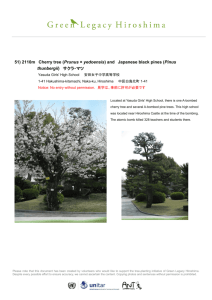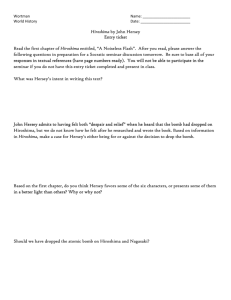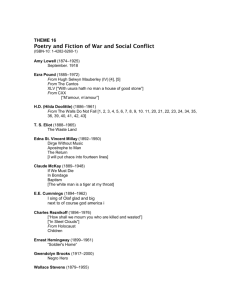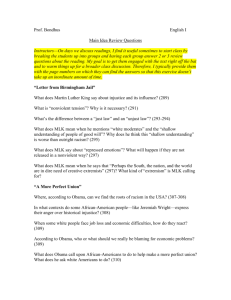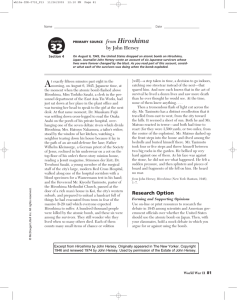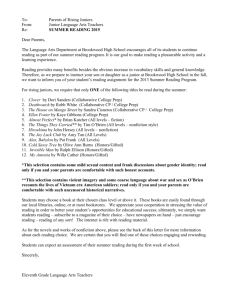Kolbowski, Raad & Hiroshima mon amour
advertisement
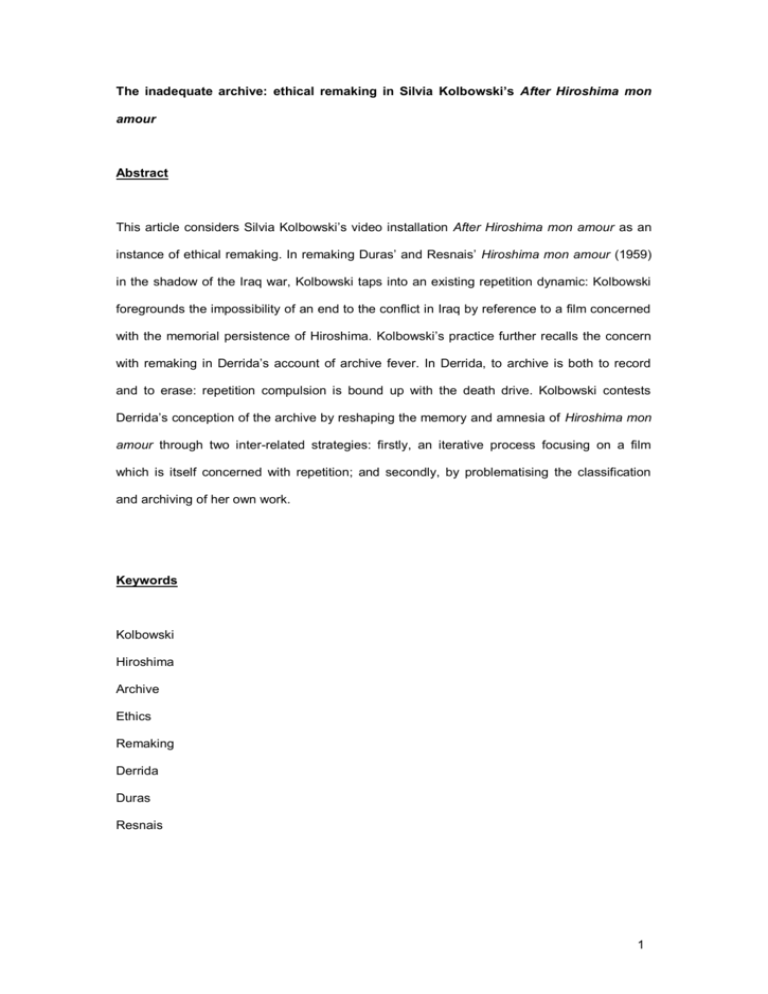
The inadequate archive: ethical remaking in Silvia Kolbowski’s After Hiroshima mon amour Abstract This article considers Silvia Kolbowski’s video installation After Hiroshima mon amour as an instance of ethical remaking. In remaking Duras’ and Resnais’ Hiroshima mon amour (1959) in the shadow of the Iraq war, Kolbowski taps into an existing repetition dynamic: Kolbowski foregrounds the impossibility of an end to the conflict in Iraq by reference to a film concerned with the memorial persistence of Hiroshima. Kolbowski’s practice further recalls the concern with remaking in Derrida’s account of archive fever. In Derrida, to archive is both to record and to erase: repetition compulsion is bound up with the death drive. Kolbowski contests Derrida’s conception of the archive by reshaping the memory and amnesia of Hiroshima mon amour through two inter-related strategies: firstly, an iterative process focusing on a film which is itself concerned with repetition; and secondly, by problematising the classification and archiving of her own work. Keywords Kolbowski Hiroshima Archive Ethics Remaking Derrida Duras Resnais 1 The inadequate archive: ethical remaking in Silvia Kolbowski’s After Hiroshima mon amour Silvia Kolbowski’s video project After Hiroshima mon amour (2005-8) is a striking intervention in the discourses by which war and trauma negotiate cultural memory. In remaking Alain Resnais’ 1959 film in the shadow of the Iraq war, and acknowledging the impossibility of assigning a stable ‘end’ to either that conflict or to Hiroshima, Kolbowski taps into the suspicion of closure and the obsessive repetition which characterise Resnais’ work. At the same time, the project signals a deeper, formal concern with remaking and with the archive which resonates with Derrida’s account of archive fever. For Derrida, the drive to archive, and to preserve memory, is bound up with repetition: ‘point d’archive sans un lieu de consignation, sans une technique de répétition’; and yet repetition compulsion is inseparable from the death drive (Derrida, 1995: 26-7). The death drive threatens ‘toute primauté archontique, tout désir d’archive’; it is, for Derrida, le mal d’archive (p.27). In Kolbowski, I suggest, the subversion of archontic primacy is accompanied by renewed faith in the ethical potential of the archive. Out of the agonistic encounter of consignation and destruction, her work pursues a process of archival remaking which contests institutional archiving and promises to reinvigorate cultural memory. In what follows, I assess Kolbowski’s After Hiroshima mon amour as a work which comments upon documentary archives, art archives and the classificatory and aesthetic procedures derived from them. Kolbowski comments upon trauma and repetition compulsion by means of two inter-related strategies: firstly, an iterative process focusing on a film which is itself concerned with repetition; and secondly, by problematising the classification and archiving of her own work. The latter strategy concerns generic classification, in particular the recasting of Hiroshima mon amour as a video installation. The move from film to video is one of a series of cross-genre transitions which disturb institutional belonging and memorial practices, furthering Alain Resnais’ refusal to provide an ‘absolute vision of Hiroshima’: (Maclear 2003: 237). The video is the major component of an installation which has been mounted in a variety of locations including Princeton University, La><art, Los Angeles (2008), the Leonard and Bina Ellen Gallery at Concordia University, Montreal (2009) and the 2 Moderna Galerija, Ljubljana (2009). The fragmentation of the viewer’s gaze courted in these iterations is pursued in the insistent process of remaking attached to the work, which has been remade as a photographic exhibition and a series of photographic documents which are further documented in Walid Raad’s Scratching on Things I could Disavow (2007). Remaking trauma The collision of trauma and desire is one of the best-known aspects of Hiroshima mon amour: the film depicts a love affair between two unnamed protagonists, ‘Elle’ (Emmanuelle Riva) and ‘Lui’ (Eiji Okada), and the chance encounter which takes place between them while She is filming a commemorative film ‘sur la paix’. The action is set in Hiroshima in 1957, twelve years after the Hiroshima bombing. The close-ups in the opening sequences alternately overlay the lovers’ bodies with moisture and with ash, poetically immersing them in the traumatic event which is the backdrop to both the affair which takes place between Elle and Lui in the present and the earlier affair between the female protagonist and a German soldier during the Occupation. These juxtapositions were instrumental in triggering the ‘shock waves’ surrounding the film’s release in 1959, and articulating the threat which, for Marie-Claire Ropars-Wuilleumier, it posed to the ‘conventional order of cinema’ (Ropars-Wuilleumier 1990: 173). Familiar as the film has become, Ropars-Wuilleumier’s analysis of its slippery status as an artefact is an apt one, and sheds further light on the encounter of the death drive and the pleasure principle which takes place within it, ultimately paving the way for my assessment of the film’s relation to the archive, in which a closely related encounter takes place. For RoparsWuilleumier, Hiroshima mon amour is both ‘unmakable and never remade’ (p.173). The latter claim is invalidated only in 2005 by Kolbowski’s radical project of remaking; the former arises from Resnais’ initial failure to make the film, and the figurative presence of the impossible film which persists within the finished Hiroshima mon amour. Resnais was commissioned to make a documentary on the Hiroshima bombing by the producers of Nuit et brouillard; he supposedly became convinced that he was inadvertently remaking Nuit et brouillard, and that 3 the new project was doomed to failure. This conviction was the theme of Resnais’ meeting with Duras in Paris, or so the story goes. Instead of abandoning the project, though, Duras famously incorporated the theme of narrative and filmic impossibility into the script which she subsequently produced: ‘Impossible de parler de HIROSHIMA. Tout ce qu’on peut faire c’est 1 de parler de l’impossibilité de parler de HIROSHIMA’ (Duras 1960 : 10). Duras proceeds to describe the documentary images which are apparently presented in the film, and the woman’s perception of them: ‘Elle lui dit qu’elle a tout vu à HIROSHIMA. On voit ce qu’elle a vu. C’est horrible’ (p.10). The documentary aspect of the early sequences is emphatic and yet it is explicitly negated by the intervention of the male protagonist: ‘Tu n’as rien vu à Hiroshima. Rien’ (p.22). Elle embodies the possibility of documentary knowledge while, in Duras’ description, ‘sa voix à lui, négatrice, taxera les images de mensongères et qu’il répétera, impersonnel, insupportable, qu’elle n’a rien vu à HIROSHIMA’ (p.10). Elle’s experience of Hiroshima is peculiarly dependent on the idea of historical fact, in particular the archival materials she views at the museum, including newsreel footage, statistics (200,000 dead) and photographs. The sequence bears an epistemological promise which is apparently corroborated when the archival materials are shown to the spectator, echoing the claim ‘j’ai vu les actualités’ (p.27). The film’s standpoint to the archive, however, is very much more complex, and opens up epistemological fault-lines which are later exploited to great effect in After Hiroshima mon amour. The female protagonist’s insistent account of the archive is infused with the desperate passion which shapes her affair with the Japanese man, and with the same sense of delusion, 'the knowledge of Hiroshima being stated a priori by an exemplary delusion of mind' (Duras 1961: 9). The claim to historical knowledge and its subsequent denial are the simultaneously deathly and erotic faces of that passion. As Nina Varsava has argued, ‘in her commanding and precise regurgitation of the museum’s contents, Riva’s character dramatizes the archival drive, what Derrida terms “mal d’archive”’ (Varsava 2011: 115). The quest for knowledge of the traumatic event, then, is bound up with the twin dynamics of recording and deletion seen in Derrida’s theory of the archive, as the feverish imperative to record brings with it a countervailing repression or erasure. For Varsava, ‘the film composes 4 “a contradictory turning to the archive and yet a contesting of its authority”’ like that seen by Linda Hutcheon in postmodern fiction (Hutcheon 2002: 77, quoted in Varsava 2011: 118-9). That contradictory turn, I suggest, becomes both more sweeping and more interrogative in Kolbowski’s project, which extrapolates from the claim, in Duras’ script, to produce ‘un faux documentaire’ (p.12). The spectre of the false documentary affords further insight into the archival anxiety which afflicts the female character, along with the archival ‘reconstitutions’ which are its symptoms. One of the immediate causes of that anxiety is the comprehensive nature of the destruction of Hiroshima, as a result of which many of the artefacts held in the museum are in fact reconstructions: Quatre fois au musée à Hiroshima. J’ai vu les gens se promener. Les gens se promènent, pensifs, à travers les photographies, les reconstitutions, faute d’autre chose, à travers les photographies, les photographies, les reconstitutions, faute d’autre chose, les explications, faute d’autre chose (Duras 1960 : 24). The archival documents which Elle consults are themselves reconstructions, opening up important questions about the forms of historical knowledge which are possible after Hiroshima. She is in Hiroshima in order to make a film which is itself a remaking of the traumatic event; her attempts to understand the event lead her to the remade artefacts which populate the archive. As Olivier Ammour-Mayeur notes, the equally uncertain ontological foundation of the love story and the ‘reconstitutions’ is indicated in their designation as contingent, ‘faute d’autre chose’ (Ammour-Mayeur 2008: 139). The process of la reconstitution, that is, remaking, spreads from a contingent archival strategy to an aesthetic procedure with far-reaching ethical consequences. It is this procedure which will ultimately produce Kolbowski’s remake, After Hiroshima mon amour. The place of sound: After Hiroshima mon amour In After Hiroshima mon amour, Kolbowski draws upon the embryonic ethics of reconstruction seen in Duras’ and Resnais’ film. The project occupies the intermedial hinterland created by Hiroshima mon amour: following the remaking of Hiroshima as ‘un film sur la paix’ and as 5 Hiroshima mon amour itself, Kolbowski remakes the film as a video installation and photographic exhibition preoccupied with contemporary (2005-8) conflicts.[figure 1] As Rosalyn Deutsche argues in her insightful study Hiroshima after Iraq, in positioning itself ‘“after” Hiroshima, an event that is not over’, Kolbowski’s project enters the continuum of Hiroshima mon amour itself, in which trauma always spills over into the present (Deutsche 2010: 21). As Deutsche suggests, ‘the video is framed by footage, appropriated from its source film, on which the artist has performed certain mediating operations, and which she has edited together with footage of war-torn Iraq and post-Katrina New Orleans’ (p.10). The ‘mediating operations’ pursued by Kolbowski, I suggest, are of three kinds: manipulation of spectatorial relations though video sound; a strategy of substitution pursued around ethnicity; and an exploitation of the work’s generic status as installation. In each case, expectations concerning archival knowledge are productively frustrated. In Hiroshima mon amour, sound contradicts the image’s claim to truth-telling, demoting it from the documentary to the specular: it is the intervention of the male protagonist’s voice that informs us that the hospital sequences are reconstructions, not documentary footage. The force of the negation which the male protagonist applies to the woman’s claim to have seen ‘everything’ is amplified by its vocalisation: the stark 'tu n’as rien vu à Hiroshima' is spoken by ‘une voix d’homme, mate et calme, récitative’. (Duras 1960: 22). The measured, almost incantatory tone of the ‘voix de lecture récitative’ (p.22) troubles the relation of text to image and of voice to text.2 While it is tempting to attempt to reconcile the two voices in the sequence with the characters of Elle and Lui, the voices remain disembodied, preventing the desired identification. Kolbowski’s work exploits two techniques focusing on sound which are already present in Hiroshima mon amour: acoustic quotation and acousmatic sound. Sound proves to create insidious forms of linkage between Hiroshima mon amour and its documentary ancestor in Resnais’ work: several critics have noted the quotation of the soundtrack of Nuit et brouillard in the opening sequences of Hiroshima mon amour.3 Resnais’ opening sequences, meanwhile, are themselves quoted in After Hiroshima mon amour, in which the original soundtrack accompanies the original images of the lovers’ bodies, albeit overlaid with Kolbowski’s title sequence in addition to that of Hiroshima mon amour itself. The troubling beauty of the ash-sprinkled bodies is cut with first-person documentary footage of 6 American soldiers entering a building during the Iraq war. Duras’s ‘J’ai tout vu. Tout’ now accompanies a confrontation between soldiers and civilians, and jerky low-definition handheld video footage replaces Resnais’ lovingly crafted black-and-white cinematography. The claim to have seen ‘everything’ is complicated by the ongoing presence of trauma in the (2005) present, when to have seen everything is to have seen New Orleans and Iraq as well as Hiroshima and Nagasaki. For all that the quotation of sound in After Hiroshima mon amour suggests continuity, it in fact reinscribes the video in the highly ambivalent repetition dynamics of its predecessor, and puts the conventions of cinema sound under intolerable strain. Large swathes of the video are silent, or accompanied only by background noise: the dialogues between the two protagonists which occupy such a prominent position in the original film are largely mute, leaving the viewer grasping for the monosyllabic sentences and crystal-clear enunciation of Resnais’ film (‘Tu me tues. Tu me fais du bien’ (p.35)). Kolbowski’s deliberately choppy editing uses silence, and periodic incursions of sound, to dislocate many of the operative relations of Hiroshima mon amour. Most strikingly, sound and image are placed out of sync for almost the entire duration of the video, drastically amplifying the original’s threat to the acoustic order. As a result, the collision of the erotic and the deathly is subject to a further collision: instead of providing respite from the traumatic sub-text, the love scenes are now immersed in it. The respite in Hiroshima mon amour is itself strictly relative, and underwritten by trauma (for instance in the match-cut between Okada’s hand as he lies sleeping in bed and the hand of the Hiroshima survivor). In the remake, however, that relation is brutally undercut. In Kolbowski, the reassuring wholeness of Okada’s and Riva’s bodies in the present, and the viable relation between their bodies and voices, is undermined. Instead of the clearly intelligible dialogue between Elle and Lui which, at least in part two, suggests naturalistic characterisation, in Kolbowski the characters embrace in a strange limbo; their lips move silently, as if in a vacuum. The sounds heard by the viewer are principally derived from ‘background’ noise, albeit from a background whose foreground is never resolved. Elle and Lui, then, are deprived of much of the jouissance which animates the original love scenes: their function now resembles that of the acousmêtre, in Michel Chion’s sense of a 7 ‘personnage acousmatique’, an indeterminate entity which is neither inside nor outside the image: On pourrait le définir comme ni-dedans ni-dehors (par rapport à l’image): ni dedans parce que l’image de sa source – le corps, la bouche – n’est pas incluse, mais ni dehors non plus parce qu’il n’est pas franchement positionné off sur une estrade imaginaire rappelant celle du conférencier ou du bonimenteur (voix de conteur, de présentateur, de témoin) et qu’il est impliqué dans l’action, sans cesse en danger d’y être inclus (109). In contrast to Chion’s description, the mouth from which the sound issues is visually present, but its acoustic referent has disappeared. Kolbowski’s technique indicates a more radical disorientation than that observed by Chion in the procedures by which speech is relativised in cinematographic sound.4 Kolbowski works against Chion’s notion of synchresis, ‘la soudure irrésistible et spontanée qui se produit entre un phénomène sonore et un phénomène visuel ponctuel lorsque ceux-ci tombent en même temps, cela indépendamment de toute logique rationnelle’ (Chion 1990: 55). As Chion notes, ‘la synchrèse peut même fonctionner sur du vide, c’est-à-dire sur des images et des sons ponctuels qui n’ont, à la lettre, rien à voir les uns avec les autres’ (56) ; nevertheless, synchresis describes a functional relation between sound and image. Important as it is, Chion’s account pays rather less attention to the obverse relationship: while ‘un synchronisme large donne un effet moins naturaliste, plus facilement poétique et plus détendu, et un synchronisme très serré tend plus fortement la toile audio-visuelle’ (57), Kolbowski works against synchronisation so comprehensively that images and sounds are no longer perceived as related at all. In part, the technique reflects the changed relation of sound and image in video as opposed to film, a relation which Kolbowski ruthlessly exploits. Chion acknowledges the change, arguing that ‘au cinéma, le cadre est important, puisque ce n’est rien moins que ce au-delà de quoi il y a le noir’ (138 ; original emphasis). His conclusion, although provocative, is problematic: ‘il est donc possible qu’il y ait un rapport précis, au sein de l’art vidéo, entre le flou du cadre et le flou du statut qui y est concédé au son’ (139). The predominant sound dynamic in After Hiroshima mon amour is one of vertiginous loss of reference, as the viewer attempts to relate images to sounds and, inevitably, fails. The 8 technique is an integral part of Kolbowski’s technique of repetition made unfamiliar, and contrasts with Chion’s sweeping claim that ‘de manière générale l’art vidéo ne pense pas beaucoup à la place du son’ (139). In the context of Kolbowski’s work, such a suggestion appears simply untenable. The anti-synchresis of After Hiroshima mon amour does recall Chion’s comment on the ‘indeterminate status’ of sound in one respect: sound and image are choreographed so as to render their relation undecidable, rather than simply antagonistic, and sound and image very occasionally coincide. In one of the scenes depicting Elle and Lui in bed (in this case the roles are played by a black woman and a white man), we are suddenly and inexplicably able to hear the off-screen sound which interrupts their (silent) dialogue, a loud cough. The video pursues the ontological problems of Hiroshima mon amour, rendering the truth-status of events as indeterminate as in Resnais’ original, but the occasional flashes of diegetic sound hold out the prospect of making sense of the narrative at a level beyond the contingency of the ‘faute d’autre chose’. Synchronisation of sound and image returns briefly at the very end of After Hiroshima mon amour, in the scene following the woman’s return to her hotel room at dawn. In its brief restoration of the relation between sound and body, this remade final scene is still more disorientating than the desynchronised sequences, and lends tremendous emphasis to the closing dialogue between Elle and Lui: ‘I’ll forget you! I’m forgetting you already! Look at me!’.5 The scene ends with a lurid red dissolve as the soundtrack returns to the opening music of Hiroshima mon amour, which accompanies a red-saturated manipulation of the early sequences in the original depicting the ash-covered bodies. Kolbowski’s video does not replicate the distant gaze with which Elle ascribes to Lui the fixity of a place (‘elle le regarde comme elle regarderait la ville’ (p.124)), and it omits the final lines in which Elle is explicitly identified with Nevers and Lui with Hiroshima (‘Hi-ro-shi-ma. C’est ton nom’ (p.124)). It does, however, point to a further network of identifications and substitutions concerning both textimage relations and ethnicity. If the closing scenes of After Hiroshima mon amour restore visualised sound and therefore point towards the conventional acoustic order of cinema, another disjunction is made apparent in visual terms: the man playing Lui is not the same as in the earlier scene in which the cough disrupts the work’s acoustic fabric. In that scene, the woman’s head rests upon the chest of a white man with a goatee; here, by contrast, He is of 9 middle-Eastern descent. She nevertheless recognises him, driving a further wedge between the relations operative in the diegesis and those which obtain in the viewer’s understanding of it. (Re)made to order: After Hiroshima mon amour and the place of the text The montage of Hiroshima mon amour retains some of its shock-value: in juxtaposing the German lover and the Japanese lover, or Nevers and Hiroshima, and in suggesting an impossible, poetic equivalence between the two, the film places viewing relations under considerable strain. At the same time, the narrative drive is such that we are able to maintain a degree of investment in the relationship of Elle and Lui despite the extraordinary identifications which it gives rise to. In After Hiroshima mon amour, meanwhile, such investment is dealt a severe blow by the process of substitution articulated around the two principal characters. Instead of negotiating the film’s juxtapositions through the familiar, iconic presence of Emmanuelle Riva and Eiji Okada, in After Hiroshima mon amour we encounter a seemingly endless succession of male and female actors, as the roles of Elle and Lui cross and re-cross boundaries of gender and ethnicity in the course of the video. The montage of the original is lent further complexity by the quotation of Duras’ text in the subtitles of After Hiroshima mon amour, suggesting explanatory mediation of the French text. In fact, though, the act of mediation extends and complicates the network of equivalences of Hiroshima mon amour, disrupting signifiers of place, gender and ethnicity. A key example occurs when Duras’ ‘synopsis’ is quoted in the first three minutes of the video, setting the images the day before the female character returns to France and introducing her encounter with the male character: ‘this anonymous woman meets a Japanese man (an engineer or architect)’ (Duras 1961: 9). Faithful as it is to Duras’ text, the claim contradicts Kolbowski’s video montage, which shows a man of middle-eastern descent at this point. His posture and gestures, lounging on a hotel room bed and smiling, recall those of Okada in Hiroshima mon amour, so that we are drawn into identifying him with the male character even as his ethnicity suggests the opposite. He is almost immediately replaced by a smiling couple, 1 0 lying in bed in another hotel room, at which point the subtitles read ‘how they met will not be revealed in the picture’. This very brief sequence, entirely silent apart from minimal background noise, then cuts to a repeated scene in which an unidentified female character draws a red cross on what appears to be a white flag. As Rosalyn Deutsche argues, this is ‘a scene that suggests questions about humanitarian law and aid’ and, for Deutsche, identifies Kolbowski’s project as a reflection on ethics and, in its depiction of Iraq, ‘the American way of war’ (Deutsche 2010: 10, 24). Promising to supply meaning on one level (through text), the sequence’s elimination of sound is highly disconcerting, flouting the conventions of cinema sound and making an implicit demand of the listener: a call to listen, ‘une intensification et un souci, une curiosité ou une inquiétude’ like that theorised by Jean-Luc Nancy in A l’écoute (Nancy 2002: 18). In the cinema, complete silence is rare, and tends to induce extreme 6 discomfort in the viewer; Kolbowski’s creation of a ‘silence-over’, in Jalal Toufic’s phrase, inhibits viewing, and is not relieved until the beginning of the longer scene involving the black woman and white man, around five minutes into the video (Toufic 2005: 91, quoted in Deutsche 2010: 15). The viewer’s disorientation is tempered somewhat by the apparently renewed intelligibility of the personal narrative, and although the lovers’ dialogue cannot be heard, an intelligible acoustic dimension at least returns in the form of background noise (the sound of insects like crickets). When the continuum of sound is interrupted by the cough, the overlapping of apparently separate diegetic spheres is underlined by the subtitles, which now reflect on the relation of the personal narrative to discourses of commemoration: ‘however little the spectator has been shown of the Hiroshima Monument, these miserable remains of a Monument of Emptiness, the spectator should come away purged of practically all prejudice and ready to accept anything that may be told about the two protagonists. And at this point, the film comes back to their own story’. Duras’ rather overloaded phrase links an absent visual signifier (the Hiroshima Monument), which has not appeared in Kolbowski’s video, to the possibility of a new form of spectatorial relation: the purging of prejudice which Duras describes suggests deep suspicion of official modes of commemorative spectatorship, a tendency which has been strongly emphasised in recent criticism on Hiroshima mon amour. For Kyo Maclear, ‘Resnais’s attempt to capture the elusive relationship between vision and 1 1 knowledge in Hiroshima mon amour is a way of indicating the hubris of the all-knowing eye’, an argument which has further implications for my reading of ethical remaking (Maclear 2003: 239-40). Despite the descriptive tone, the words ‘at this point’ in fact trigger footage of Iraq. Instead of the advertised return to the intimacy of the lovers’ embrace, we view a washed-out Iraqi highway from the vantage point of an American military vehicle. ‘Their embrace, so banal, so commonplace’, we read, ‘takes place in the one city of the world where it is hardest to imagine it’. Far from reducing the impact of the video, the wholesale transposition of signifiers of place which occurs in After Hiroshima mon amour represents a telling, and curiously faithful engagement with Hiroshima mon amour itself. Just as Elle and Lui are divested of their individual identities (‘ils ne sont en effet encore personne’ (p.17)) and substituted for the places associated with their past histories (Nevers, Hiroshima), Hiroshima is now exchanged for Iraq and, following Hiroshima mon amour, personal history and historical memory are locked in a relation of undecidability. The traffic briefly eases; as the vehicle clears a crossroads, a single word appears in the subtitle area: ‘Hiroshima’. Instead of functional signification, text amplifies the disorientation wrought by sound; the image of Iraq is accompanied by a quite remote signifier of place. Kolbowski’s subtitles quote Duras’ desire to ‘have done with the description of horror by horror, for that has been done by the Japanese themselves’ (Duras 1961: 9). Alluding to the plethora of documentaries in existence by the time of Resnais’ commission, Kolbowski and Duras suggest a move away from documentary conventions. Immersion in the ‘banal’ love story or, equally, the transposition of the narrative into an entirely different geographical location, suggests an abdication of documentary ethics. In fact, however, the return to the couple in bed which follows these sequences heralds a reconstitution of the documentary form and a promise of ethical renewal. In an apparent return to a matching relation between subtitles and images, the subtitles claim ‘their personal story always dominates. If this condition were not respected, this film would be just one more made-to-order picture, of no more interest than any fictionalised documentary’ (p.10). For Kolbowski, the intrusion of the personal story is a condition of formal innovation, and of avoiding the documentary ‘to order’: ‘if it is respected, we’ll end up with a sort of false documentary, that will probe the lesson of Hiroshima more deeply than any other made-to-order documentary’ (p.10). It is through the 1 2 incursion of the love story into the documentary that the possibility of documentary is paradoxically reinstated; spectatorial disorientation is pursued in the unfaithful caption, which adds the word ‘other’ to Duras’ statement on the made-to-order documentary. Kolbowski implies that After Hiroshima mon amour is indeed a made-to-order documentary, skewing the sense of the original and adding another fictional premise to the array of disingenuous statements that the viewer must negotiate. The subtitle is accompanied by a striking photonegative rendering of the actors’ bodies, reducing them to unsignifying forms locked in an inscrutable embrace: our recognition of Elle and Lui is compromised by the substitution of bodies which takes place throughout After Hiroshima mon amour, and even when the ‘original’ protagonists of Kolbowski’s project return, they are no more straightforwardly selfidentical than the anonymous bodies in the opening sequences of Resnais’ film. In both linguistic and visual terms, After Hiroshima mon amour relentlessly draws attention to its own status as a fabricated, and refabricated, artefact. The chromatic inversions suggest mediated images, images which have always already been converted from an unseen source; equally, the subtitles point to an original text which is only marginally present in the finished film Hiroshima mon amour. Duras’ script is the archival pretext of Resnais’ film: it is relegated to an unseen repository instead of appearing explicitly in the film, and yet it unexpectedly reappears, as translated text, in Kolbowski’s remaking. Marie-Claire RoparsWuilleumier draws attention to the intermedial undecidability of Hiroshima mon amour, noting Resnais’ aim to ‘create at the cinema the equivalent of the reading process’, while Duras’ script ‘only generates the writing to turn it to the sole advantage of the film’ (RoparsWuilleumier 1990: 175).7 Each is dependent on its impossible other, which underpins its existence but cannot be made visible within it. At the conclusion of her essay, RoparsWuilleumier explicitly links the problematics of remaking to the documentary form, noting that, despite the danger of doing so, ‘Hiroshima mon amour does not remake Nuit et brouillard’. Instead, ‘Hiroshima marks the moment when, in the aesthetic world, that consciousness of an irreducible gap between facts and their formulation emerged’ (p.183). The relation of film and script in Hiroshima mon amour poses one kind of archival dilemma; another, meanwhile, is seen in the film’s standpoint to documentary, and in Kolbowski’s response to it. As Ropars-Wuilleumier and Maclear suggest, Resnais’ film 1 3 interrogates the procedures by which documentary artefacts produce historical discourses of memory. Nina Varsava’s analysis goes further, emphasising the film’s espousal of ‘an ethics of representation that resists the violence of positivist accounts of history’ (Varsava 2011: 111). Noting the prominent role of the archival in the film, Varsava argues that ‘the film incites criticism of the injustice that archival discourses enact on the particularities of trauma, and raises questions about the ethics as well as the truth-value of conventional commemorative tropes’ (p.111). Those questions, I suggest, are posed still more insistently, and create a larger discursive framework, in Kolbowski’s remaking, while continuing to dog contemporary critical debate on Hiroshima mon amour. In her account of the ‘antipositivist, deconstructivist sensibilities’ of Hiroshima mon amour, Varsava refers to Kyo Maclear’s work, in which the film is explicitly taken as a model of deconstructionist ethics (Maclear 2003, quoted in Varsava 2011: 119). Rejecting the oftrepeated charges of nihilism and the claim that historical reference is fictive, Maclear repositions deconstructive procedures as attentive to the gaps in historical knowledge occasioned by trauma (Maclear 2003: 234-35). For Maclear, the ‘archival history’ which the female protagonist attempts to construct is undermined by the film’s restlessly shifting viewpoints, adding a multiplicity of perspectives to the unity suggested by the figure of the archive (p.237). The argument is valuable in the encounter it suggests between Derrida’s theory of the archive and the archival ethics of Resnais and Kolbowski; that ethics, I suggest, is the occasion for the remaking of Hiroshima mon amour as installation. [Figure 2] For Maclear, there is a connection between the perceived inwardness of deconstruction and some recent tendencies in conceptual art, in particular the ‘growing emphasis on conceptual minimalism in North American art practice, a bias towards postmodern abstraction and installation work’ (p.235). Maclear proposes that these tendencies bear an ethical potential analogous to that in deconstruction: ‘in valorising creative minimalism and aestheticising memory “gaps”, we may bypass the particular responsibilities involved in negotiating with the limits – the remains – of any given commemorative practice’ (p.235). Ambivalent as it is, Maclear’s interest in such memory gaps is a provocative one. Her account of ‘limits’, moreover, is specifically rooted in Drucilla Cornell’s Philosophy of the Limit, and the imperative to assess the ‘ethical implications of partial memory’ which Maclear sees 1 4 there (p.235). Cornell’s work is further provocative in the context of Kolbowski’s aesthetics of remaking in its emphasis on reconstruction. Cornell argues passionately for a reassessment of the ethical potential of deconstruction; for Cornell, deconstruction is not condemned to ‘leave historical representations in an “unreconstructable” litter, thus undermining the possibility of determining precepts for moral action’, but is capable of expressing the limits of historical knowledge encountered in traumatic events (Cornell 1992: 1, quoted in Maclear 2003: 244).8 While much debate has raged around deconstruction and ethics since the publication of Cornell’s work, Maclear’s appropriation of it signposts further implications of the strategies deployed by Kolbowski in After Hiroshima mon amour, where remaking is bound up both with the intermedial refashioning of the project and with the twin archival dynamics of recording and erasure identified by Derrida.9 Conclusion: ethical remaking beyond the archive If the archive is ‘an officially sanctioned repository of objects and documents that reinforce a group or nation’s identity and origins’, it is also an unstable domain in which notions of truth and reference may be radically relativised (Takahashi 2007: 179). In deleting historical reference and muddying ethnic and geographical specificity, Kolbowski appears to replicate Derrida’s vision of the implication of the death drive in the archive. For Derrida, the death drive ‘ne pousse pas seulement à l’oubli, à l’amnésie, à l’annihilation de la mémoire, comme mnémè ou amámnesis, elle commande aussi l’effacement radical, en vérité l’éradication de ce qui ne se réduit jamais à la mnémè ou à l’anámnesis, à savoir l’archive, la consignation, le dispositif documentaire ou monumental comme hupómnema, supplément ou représentant mnémotechnique, auxiliaire ou aide-mémoire’ (Derrida 1995 : 25-6). One reading of Derrida’s theory of the archive focuses on the literal acts of repression and amnesia which accompany archiving, as official history blanks out contents deemed inappropriate or inexpedient by the institutional power creating the archive, in ‘an incessant historical violence – a violence it bears within itself in the form of preservation of cultural memories eradicated from culture itself, and the articulation of an authority established precisely by such eradication’ (Hutchens 1 5 2007: 38). Kolbowski’s work, though, does not merely inscribe itself within the twin dynamic of consignation and erasure, but engages with the archive’s creation of institutional authority. The scope of that engagement spans cultural history and international politics: Kolbowski’s relentless interrogation of the institutional grounding of art historical discourses and practices results in an inadequate history of conceptual art (1998-99), which apparently creates an alternative, oral history of conceptual work in which the names of artists and art-works have been deleted. By After Hiroshima mon amour, Kolbowski’s work has widened in focus from art archives to the often fragmentary histories of conflict zones. Remaking, instead of the frenetic process whereby inscriptions overlay and obscure one another, now becomes a concerted aesthetic and ethical strategy in which the fragmentary architecture of the installation chimes with the epistemological conundrum of trauma. In evoking two contexts in which reconstruction has an urgent ethical meaning, reconstruction-era Iraq and post-Katrina New Orleans, Kolbowski reconstitutes her work ‘as an object and a field of resistance’ to archival violence (Thériault 2009: 4). It is by fostering ‘a spectatorial position that foregrounds the structures of the unconscious in relation to the political realm’ that Kolbowski mounts an urgent critique of archival power, scrutinising the death drive and replacing its incessant repetition with the ambivalent dynamic of remaking (Raad 2006: 70-1). 1 6 References Adl er , Laure ( 2002 [1998]) . M arguer ite Dur as . Pari s : Galli mar d . A mmour - Mayeur , Oli vi er (2008). ‘T émoi gner de l ’i ntémoi gnable: Hi r oshi ma e ntr e « reme mbr ance » et vesti ges de l a mé moi r e (sur Hirosh ima mon amour et Pluie n oire)’, Interférences Littéraires, 1, 133-44. Ar mes, Roy (1968). The Cinema of Alain Resna is . London: (1994). Critical Zwe mmer. Caruth, Cathy and Esch, Deborah (eds.) Encounters: Reference and Responsib ility in Deconstructive Writing. New Bruns wick, New Jersey: Rutgers University Press. Chion, Michel (1990). L’Audio-vis ion. Paris : Nathan. - (1994). Audio-Vis ion: Sound on Screen. Transl. Claudia Gor bman. New Yor k: Col umbi a Uni ver si ty Pr ess. Col pi , Henri ( 1960) . ‘Musi que d’Hi r oshi ma’, Cahier s du ciném a, 18 (103) : 1-14, Cornell, Drucilla (1985). ‘Toward a Moder n/Postmoder n Reconstruction of Ethics’, University of Pennsylvania Law Review 133 (2): 291-380. –– (1992) The Philosophy of the Lim it. London: Routledge. Cr i tchley, Si mon ( 1992) . T he Ethics of Deconstr uction: Der r ida and Levinas. Oxford: Blackwell. 1 7 Dados, Nour (2009). ‘Anything Goes, Nothing Sticks: Radical Stil lness and Ar chi val Impul se’, M /C Jour nal 12 ( 1) , speci al i ssue, still. http://jour nal .medi a - cul tur e.or g.au/i ndex.php/mc jour nal /ar ti cle/vi ewAr ti cl e/126 ( consul ted July, 2011). Derrida, Jacques (1995). Mal d’archive: une impression freudienne (Paris: Galilée, 1995) Duras, Marguerite (1961). Hiroshima mon amour. New York: Grove Press. – – . Hir oshim a m on am our ( 1960) . Par i s : Gal li ma r d. Figgi s, Mi ke (2003) ‘Si lence: The Absence of Sound’, i n L. Si der (ed.), Soundscape: The School of Sound Lectures, 1998 -2001, pp.114. London: W allflower Press. Hughes, Robert (ed.) (1962). Film: Book 2: Films of Peace and War. New York: Grove Press. Hutchens, Benjami n (2007). ‘Techniques of Forgetting? Hypo - A mnesi c Hi stor y and the An - Ar chi ve’, SubStance 36 ( 2: 113) , The Future of Anarchism : 37-55. Hutcheon, Linda (2002). The Politics of Postmodernism. London: Routledge. 1 8 Lepecki, Andre (2006). ‘“After All, This Terror W as Not W ithout Reason”: Unfiled Notes on the Atlas Group Archive’. The Drama Review, 50 (3): 88-99. Macl ear , Kyo ( 2003) . ‘T he Li mi ts of Vi sion: Hir oshim a m on am our and the li mi ts of r epr esentati on’, i n Ana Dougl ass and T homas A. Vogler (eds.). Witness and memory: the discourse of trauma, pp.23348. London: Routledge. Nancy, Jean-Luc (2002). A l’écoute. Paris: Galilée. Raad, W alid and Atlas Group (2007), Scratching on Things I Could Disavow: Some Essays from the Atlas Group Project . Kulturgest. Raad, W alid and Kassandr a Nakas and Bri tta Schmi tz ( 2006) . The Atlas Group (1989-2004): A Project by Walid Marie -Claire (1980). ‘The Raad. Buchhandlung W alther König. Ropar s -W uill eumi er , Di sembodi ed Voice: India Song’, Yale French Studies, 60: 241-68. ––(1990). Hirosh ima mon Vincendeau ‘How History amour (eds.), Begets (1959), French in Film: Meaning: Susan Texts Al ai n Hayward and Resnais’ and Contexts, Ginette pp.173-85. London: Routledge. Russell -W atts, Lynsey (2009). ‘Analysing Sound and Voice: Refiguring Approaches to the Films of the 'Indian Cycle'’, in Maule, Rosanna and Julie Beaulieu, eds.(2009). In the Dark Room : Marguerite Duras and Cinema , pp.235-58. Oxford: Peter Lang. 1 9 Spieker, Sven (2008). The Big Archive: Art from Bureaucracy. Ca mbr i dge, MA: MIT Pr ess. Takahashi, Tess L (2007). ‘The I magi nar y Archive: Cu rrent Practice’, Camera Obscura 66, 22 (3): 179 -84. Toufic, Jalal (2005). ‘Jalal Toufic; an interview by Kaelen W ilson - Gol di e’, i n Jer r ol d Shi r oma ( ed.) , T owar ds a F oreign Likene ss Bent: Translation . Sausalito, CA: Duration. Thériault, Michèle (2009). ‘ Models of Intervention: A discussion between Michèle Thériault and Silvia Kolbowski’, in Silvia Kolbowski and Michele Theriault, Nothing and Everything; Rien et Tout. Montreal: Gal eri e Leonard & Bi na El len / Concordi a Uni versi ty. Var sava, Ni na ( 2011) . ‘Pr ocessi ons of T r auma i n Hir oshim a m on amour: towards an Ethics of Representation’, Studies in French Cinema 11(2): 111-23. W ilson, Emma ( 2006) . Alain Resnais . Manches ter : Manchester University Press. 1 For an early account of the meeting between Resnais and Duras, see Armes 1968; for more recent analysis, see Wilson 2006: 48; see also Adler. 2 The expression is undertranslated in the English text, being rendered simply as 'flat, muffled, monotonous, the voice of someone reciting' (p.15) 3 In this context, see Colpi 1960, quoted in Wilson 2006: 50. For Resnais’ account of the importance he and Duras placed upon the score, see Hughes 1962: 56-57. 4 The principal techniques which Chion considers are rarefaction; proliferation and ad libs; use of foreign languages; narrative commentary over dialogue; submerged speech and loss of intelligibility; decentering; and emanation speech. See Chion 1990 : 151-54. 5 ‘Je t’oublierai! Je t’oublie déjà! Regarde, comme je t’oublie! Regarde-moi !’. (Duras 1960 : 124). 6 Director Mike Figgis comments on the unacceptability of complete silence in mainstream cinema: “It was something I’d wanted to do my entire film career, which is basically have nothing on the soundtrack. Every time I’ve tried to do that in the past, a sound person has said, ‘No, you can’t have nothing on a soundtrack. If you want silence, you have to approximate silence with what’s called “room tone”. It’s like quiet white noise. But you can’t have zero’” (Figgis 2003: 1). 2 0 7 On the interplay of text and voice in Duras’ cinema, see also Ropars-Wuilleumier 1980 and, for a recent response, Russell-Watts 2009. 8 On the ‘reconstruction’ envisaged by Cornell, and the specific contextualisation of deconstruction which it achieves, see also Cornell 1985. 9 In this context, see for example Critchley 1992 and Caruth and Esch 1994. 2 1

